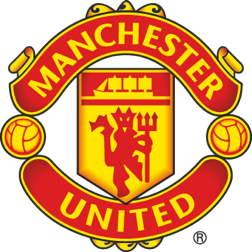Made in Manchester: The story of United's youth system
Tom Manley. The name probably won’t mean all that much to modern United fans, but when the teenage debutant strode out at Old Trafford in a 2-0 victory over Millwall on 5 December 1931, it was a moment in time for the club.
It could arguably be claimed that strapping 6ft 1in half-back Manley – 19 years and 59 days old – can be considered the first true United ‘youth product’, as a player schooled within the club before the age of 18 who was now graduating to appear in the first team. So began a pioneering trail that changed United as a club, and the wider game, forever (with due respect to Walter Whittaker and Sidney Tyler, both name-checked in the book Sons of United by authors Steve Hobin and Tony Park – authorities on the history of United’s youth and Academy teams – as earlier examples but whose senior Reds careers were very fleeting).
Better-known names such as Johnny Carey, Stan Pearson, John Aston and Charlie Mitten – all stalwarts of Sir Matt Busby’s feted post-War FA Cup and league winners – would follow in the late 1930s before the real explosion of talent with the Busby Babes, but a case can be made for Manley’s debut as the wellspring.
Marcus Rashford and Scott McTominay are among today’s graduates from United’s youth ranks, but behind them are plenty of others with hearts and minds firmly set on a first-team shirt. In fact the well-oiled conveyor belt ferrying United’s lads from juniors to first team reaches a landmark with the visit of West Ham this afternoon: that match will mark 85 years in which at least one youth graduate has appeared in every single matchday squad.
The proud run has been traced back to the trip to Fulham on Saturday 30 October 1937. That day at Craven Cottage, the same Tom Manley, by now a well-established first-teamer in his mid-20s (whose goal had helped stave off relegation to the third tier in 1934/35) appeared alongside another youth product, diminutive winger Jackie Wassall, 18 years and eight months, playing his 15th match in the senior team having been recruited aged 17 and developed through reserves football. The two men carried a baton that day that was to be passed on for the next 85 years and counting, as players to have passed through United’s youth development system and gone on to feature in the first-team squad.
Marcus Rashford and Scott McTominay are among today’s graduates from United’s youth ranks, but behind them are plenty of others with hearts and minds firmly set on a first-team shirt. In fact the well-oiled conveyor belt ferrying United’s lads from juniors to first team reaches a landmark with the visit of West Ham this afternoon: that match will mark 85 years in which at least one youth graduate has appeared in every single matchday squad.
The proud run has been traced back to the trip to Fulham on Saturday 30 October 1937. That day at Craven Cottage, the same Tom Manley, by now a well-established first-teamer in his mid-20s (whose goal had helped stave off relegation to the third tier in 1934/35) appeared alongside another youth product, diminutive winger Jackie Wassall, 18 years and eight months, playing his 15th match in the senior team having been recruited aged 17 and developed through reserves football. The two men carried a baton that day that was to be passed on for the next 85 years and counting, as players to have passed through United’s youth development system and gone on to feature in the first-team squad.
The story behind our 85-year record
ArticleWe spoke to youth football historian Tony Park about the landmark United are set to hit during the West Ham game.
CREATING THE ENVIRONMENT
The spectre of war in Europe was still two years off at this point, and although it is the post-War period that is rightly hailed as a hugely significant phase in the development of United’s youth philosophy and vision under Matt Busby, these 1930s years were also a crucial time during which measures were taken that would help create the environment in which Busby later flourished.
One development was, in 1932, United for the first time creating an ‘A’ team – the club’s third level at the time, after the first team and the reserve team (which had long competed in the Central League set up in 1911/12 and becoming essentially a competition for Football League second-string sides) – which would compete in the amateur Manchester League and be largely a vehicle for promoting and developing young players from the local area.
“By running a team in the Manchester League,” wrote manager Scott Duncan in the Manchester Evening Chronicle at the time, “we shall be able to give all likely juniors a chance of showing their paces, and United hope to discover from their number more than average finds.”
Duncan also gave an insight into some of his personal philosophies on youth, describing the practice of young players being “held in reserve to develop their talents, develop their muscles and build up their frame so that in time they could step in [to the first team] and do themselves justice”, while also delivering the Busby-esque soundbite: “To hurry along a youngster is a big mistake, but the junior must be assured that his time will come.”
Another key moment was the founding of the Manchester United Junior Athletic Club – MUJAC – which came into operation in 1938 (by which time Duncan had moved on and Walter Crickmer was now secretary manager) as a ‘schoolboy football scheme’ that collaborated with local educational authorities to create a Manchester United youth team – and to provide training facilities and coaching – for aspiring young footballers.
“They’d considered having a colts team, before that, in the early 1930s,” explains club museum curator Mark Wylie. “James Gibson, the chairman then, had spoken of a ‘United composed of Manchester players’.”
Under Gibson, Crickmer and Louis Rocca – the scout and arch-fixer whose wartime letter to Busby alerted his interest to United’s managerial position – MUJAC implemented two new youth sides to add to the club’s system, a first XI and a second team, which would provide the gateway for young players who, if they passed muster, could follow a pathway up through the club’s tiers with the ultimate prize being a place in the senior team.
“History was created in Manchester United football circles today,” wrote football journalist Alf Clarke (later to be a victim of the Munich Air Disaster) in the Manchester Evening Chronicle on 3 September 1938. “This afternoon there are no fewer than five United teams on duty. They are the senior side, Central League eleven, ‘A’ team, MUJAC first team and MUJAC second eleven... No club in the country is better served with junior players than Manchester United.”
The MUJACs were quickly a success. In their first campaign, 1938/39, playing in the Chorlton Amateur League, the team – featuring Pearson, Mitten and Aston – fizzed in an eye-popping 223 goals. With the first team back in the top flight, Gibson’s promise was taking shape. Unfortunately, however, the outbreak of the Second World War meant that 1938/39 was the last season before the Football League was halted for the long duration of the hostilities, putting United’s plans – and the game itself – in suspended animation.
Explained: United's incredible Academy landmark
ArticleWednesday is a proud day for the club, as we celebrate an astonishing 87-year sequence.
BUSBY’S LOCAL HEROES
When war loosened its grip in 1945, the Reds, with Busby taking the reins, would put the yo-yo years behind them and stay in the top flight; and how that scattering of youthful seeds would bloom, concretising that association with homegrown talent. Indisputably, United’s love affair with the exuberance of youth properly flourished on Sir Matt’s watch, his Babes bequeathing a captivating time-capsule; a big-bang moment in which football burst scintillatingly out of monochrome into a riot of colour.
In truth, Busby was as much alchemist as he was magician. His genius, in tandem with right-hand-man Jimmy Murphy, lay in finessing and cementing that outlook as club policy, standardising it as our thing. Local heroes would make United an emblem of civic pride, an inspiration for the blue-collar masses, among whom the best, the boys good enough to keep jumping through the selection hoops, could hope to one day proudly put on that red first-team shirt. It was an ideal for living, and one swiftly and richly reinvigorated after Alex Ferguson’s arrival in the autumn of 1986.
While war had put everything on hold, the cessation of hostilities spiked the need for players, particularly younger ones. So many had been lost to the game through death, injury or age. Encouragement was required to finesse the skills of the new generation. A post-War FA County Youth Cup had been a start, but things really took off when FA secretary Stanley Rous green lit a knockout competition for 15-to-18-year-olds, and in 1952 the FA Youth Cup was born.
For United this was a call to arms. Now with a network of 11 dedicated scouts across England and Ireland, overseen by Busby’s old team-mate Joe Armstrong, to whom he referred as the ‘gentlemen ferret’ in honour of his uncanny ability to unearth talent, this proved a seismic moment in United’s history.
“The systemic way United had gone about things, with the desire to get the lads trained up, put them ahead of the game – giving them a trade or something they could fall back on if they didn’t make it – that was quite forward-thinking,” says Wylie. “And that dedication behind the scenes to getting the best out of these kids still goes on today – making not just great footballers, but well-rounded human beings.”
Between 1953 and 1957, United certainly schooled the competition in the FA Youth Cup, showcasing the finest youngsters England had to offer, kids having the time of their lives against a fast-changing cultural backdrop.
That initial 1953 success – hammering Wolves 7-1 in the first leg in front of close on 21,000 at Old Trafford – featured Duncan Edwards, Eddie Colman, Billy Whelan, David Pegg and Albert Scanlon (the latter the only of those to survive Munich). That vintage was a riot of talent, as Manchester Chronicle reporter Keith Dewhurst poetically observed in his book When You Put On A Red Shirt.
“I saw Duncan Edwards cruise through opponents like a dreadnought, snake-hips Eddie Colman shuffle and swerve them onto their backsides, and David Pegg produce drag-backs like Puskas or Ronaldo. They were the days when one’s youth would last forever, it seemed, and life would give us all our due reward.” Coming through next were Bobby Charlton and Wilf McGuinness – both of whom played in 1954’s Youth Cup win – and Shay Brennan, who appeared the following season.
Munich put a hard stop to the all-conquering sequence, but 1964 brought the sweetest of treats: the mould-breaking George Best, who appeared in that year’s Youth Cup final victory over Swindon Town. Best, alongside hat-trick hero David Sadler and John Aston Jr, following in his father’s footsteps, would graduate to European Cup victory in 1968. Others off the production line aiding and abetting 1965 and 1967’s First Division title triumphs included Bobby Noble, John Fitzpatrick and Jimmy Rimmer.
Top 10 goals by the Class of '92 Video
Top 10 goals by the Class of '92
TOP 10S | Watch our countdown of finishes by the incomparable Class of '92...
FERGUSON’S ‘LIFEBLOOD’
Though the 1970s and 1980s were not barren decades – with Arthur Albiston, Norman Whiteside, Mark Hughes and Clayton Blackmore among the notable names – it was the arrival of Alex Ferguson in 1986 that restored the picture painted by Busby.
“I have always considered the player you produce better than the one you buy,” he averred, seeing the future in 1992’s Six Years at United. He acutely understood Busby’s modus operandi, the connections, or the ‘lifeblood’ as he put it. Under the watchful gaze of Collyhurst-born Brian Kidd, European Cup winner of ’68, and Eric Harrison, that fabled class of ’92, boosted by the expanded focus Ferguson’s era had ushered in, brought home a first FA Youth Cup since 1964. And what riches. Beckham, Giggs, Scholes, the Nevilles, Butt – a glorious reboot of that 1950s dream, and the eventual realisation of Busby’s European Cup quest. United won everything with those kids. The FA Youth Cup tally currently stands at 11 after May 2022's triumph, 11 years on from 2011's victory that had Paul Pogba and Jesse Lingard among the XI that beat a Sheffield United side containing Harry Maguire.
The enduring fascination with United’s youth system lies not just in the ‘you saw them here first’ moments for those that later made it, either at Old Trafford, or elsewhere – David Platt and Gerard Pique to name two that got away – but also in those ‘sliding doors’ stories, successes that might have been had the dice fallen differently. Take Ray Baartz. Baartz, 17 just six months earlier, arrived off the plane from Adamstown, Australia, in the summer of 1964. The club’s first junior signing from outside the British Isles, he was initially given a six-month scholarship. Having impressed as a striker he was offered a professional contract in April 1965. But he would never play a first-team game for the Reds. Desperately homesick, he called time on his United adventure in the winter of 1966, returning Down Under – where he would play 48 times for his country and was named in the nation’s greatest team in 2012. His experience was nevertheless critical.
“The professionalism at Manchester United made me into the footballer I became,” Baartz reflected in Sons of United, to reference Hobin and Park’s weighty account of United’s youth again – a book that, fittingly, took 18 years to produce, tracking down 500 players to have appeared for United in the Youth Cup.
Beckham, Giggs, Scholes, Edwards, Charlton and Best corner the headlines whenever United’s youth policy is discussed, but there are countless other Ray Baartzes in that endless procession of youngsters on their way to manly – or Manley – deeds since October 1937. Their achievements continue to thrill – the past’s hand on the shoulder of the present, defining the future. Theirs is a light that will never go out.




